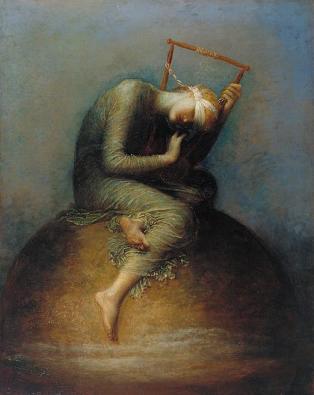 Mike wanted to talk with his students about perseverance and hope, but found that difficult; most students thought of hope in terms of optimism, and some seemed to have little resilience.
Mike wanted to talk with his students about perseverance and hope, but found that difficult; most students thought of hope in terms of optimism, and some seemed to have little resilience.
“I decided to take an indirect approach and use a painting called Hope by Frederic Watts, a painting that initially looks hopeless. I darkened the room and just had the picture of ‘Hope’ showing on the screen. I also played some music (I used Frozen Oceans from the Blue Planet, by George Fenton). I asked the students to say what they could see, and we talked about the mood of the painting and the feelings it created. I asked them to guess the title. No one said hope. I revealed the title and asked them look again to see if there were any clues in the painting as to why it is called ‘Hope’, but they found this difficult. I took the students through some of the indications of hope:
- ‘Hope’ is a blindfolded female figure who sits all alone on an unstable world floating on the sea (how some feel about life). She is vulnerable yet not overcome, and she remains seated on her world.
- She huddles over a harp with only one string. All the others are broken, yet she plays her one-stringed harp, determined to make music.
- The colors are mostly cold greens and grays, and they are hazy (hope often keeps us going when life is bewildering and unclear). There is a single small star in the sky that the woman cannot see. Not being able to see it does not change the fact that it is there. Any hope she has does not depend on sight but looks to the unseen future, trusting that there is some source of direction there.
“This is not cheery optimism; this is hope when things are bad. We looked at the painting’s story (http://www.wattsgallery.org.uk/gf-watts/hope-gf-watts) and how the hope it embodied had changed people’s lives. We went on to talk about what sort of hope keeps us going in difficult times.”
Mike saw his art lesson as an appropriate place to explore hope and connect it with purpose and trust rather than optimism.
He engaged students indirectly through a painting and helped them to engage more of their senses (picture, music, words) in order to spark their imagination. He aimed for a more reflective, contemplative kind of engagement.
Mike reshaped his practice by choosing resources that would evoke his theme (picture, music) and using them together with lighting. He also chose questions to create the right atmosphere.
People often cling to hope in the midst of difficult times, because the human heart—though often tempted to despair—insists on hoping for something better. Because Christian hope is founded on God and not human achievement or feelings, we do not have to feel a sense of optimism in order to have hope. For Christians, hope is a deep knowledge that evil does not have the last word, because Christ was victorious over sin and death on the cross. One day the world will be made anew and it will be a place of justice, joy, love, and peace. Christian hope lets faith in God and his future change the present. Faith in God’s goodness gives hope for today and tomorrow.
Mike was aware of the problems students had with lack of resilience in life. He wanted to move them from a position of giving up too easily to one of perseverance with hope. To do this he needed them to stop seeing hope as cheery optimism and begin to seeing it as something that could help when they felt discouraged, which is very different from the pressure to be happy and keep smiling. He found a way to involve their imaginations.
This lesson could be part of a wider program of building resilience, something that is crucial for learning and for life. In other areas of art, paintings can create a new way of seeing different aspects of life and offer lasting images to students.
Christian hope is rooted in Christ’s victory over sin, his death on the cross, and the belief that one day the world will be made anew and there will be no death, sorrow, or pain (Revelation 21:4). The Bible sees hope as beginning to live the future now, living a little of the values and relationships of heaven while on earth as a sign pointing to a better future. Christians are not called to do this alone but as coworkers with God (2 Corinthians 6:1). The Christian lifestyle is hopeful, testifying that good is stronger than evil, that love is stronger than hate, and that life is stronger than death. Christian hope is communal; it is not about wishful thinking but about trust. We think not only of our hopes but also of our hopes for others and what we may be able to do to realize those hopes.
God is looking for you and me to be fellow workers with God. Bishop Desmond Tutu
Each group of Christians is, as it were, a pilot plant, showing that something can be done in the present situation, if only we begin in the right way. Francis Schaeffer
Without the Holy Spirit, perseverance is difficult since it is the Spirit who empowers and strengthens. Hope is closely linked to perseverance (Romans 5:3-5 ). The Apostle Paul talks about persevering in a race toward the finishing line because of his hope in Christ. (Romans 8:24-25).
